Thread lifts have shot into the spotlight in recent years following endorsements from a number of celebrities. Doctors across the country seemed dubious about the treatment for its side effects (in some cases, threads would split, producing an uneven face). But now, years later, with new technological advances behind it, the thread lift is deemed a viable option for those looking to tighten up loose, aged and wrinkled skin. It has become a favourite among celebrities and many of our clients, providing a more permanent solution to Botox. It offers an excellent opportunity to define areas of your face, such as the cheeks or jawline, without looking unnatural, giving you a youthful appearance and an abundance of confidence.
If you are interested in this treatment, our experts at our skin clinic in Milton Keynes understand that it can be daunting to try a procedure before knowing all the facts. For this reason, we have covered everything you need to know, from what is a thread lift to its advantages.
What Is A Thread Lift? All You Need To Know
In the past, if you were looking to reduce the signs of ageing, you usually had one of two options: Botox, which would work temporarily and require regular top-ups or a complete facelift that requires long healing times. Unlike these procedures, a thread lift offers similar results to a facelift without the downtime. This allows you to create a natural lifting effect in areas that have begun to sag due to age but offers a more permanent solution to Botox. We always advise our clients to do their research before coming to the clinic to ensure that they are well-informed about the treatment they wish to have. However, our doctors are more than happy to discuss options and everything you need to know so that you can make an informed decision.
If you have been considering options for some time but are unsure that a surgical facelift is right for you, then a thread lift is the perfect alternative. To give you more insight and further information on this treatment, here is everything you need to know:
- What Is A PDO Thread Lift?
- Advantages Of A Thread Lift Over A Facelift
- The Ideal Candidate For A Thread Lift
- Celebrities Who Have Had A Thread Lift
- What Are The Threads Made From?
- What Happens During The Thread Lift Procedure?
- How Long Does A Thread Lift Last?
- Are Thread Lifts Painful?
- Dos And Don’ts After A Thread Lift
- How Much Is A Thread Lift?
- Thread Lift Before And After Pictures
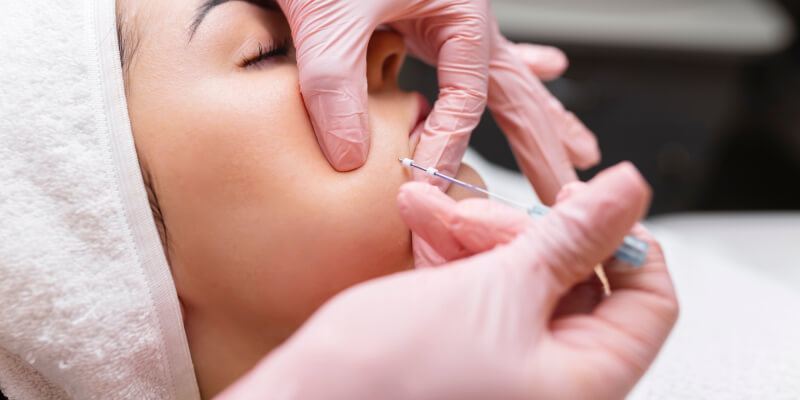
What Is A PDO Thread Lift?
Thread lifting is a procedure that works to tackle sags and folds. The procedure is becoming more popular than ever before. Hailed as a solution for both women and men that side-steps the commitment, healing time, and money required for a facelift, invisible fine threads placed in the skin can get to places on faces that other procedures cannot.
The thread facelift or thread neck lift is a minimally invasive procedure for the face, neck, or jowls in which threads that have small barbs on them are inserted under the skin via a large needle. The barbs then grab hold of the skin from underneath, pull it to anchor, and re-suspend it in a lifted, more youthful position.
If you have any queries regarding our thread face lift in Milton Keynes, then please feel free to contact the team to arrange a consultation!
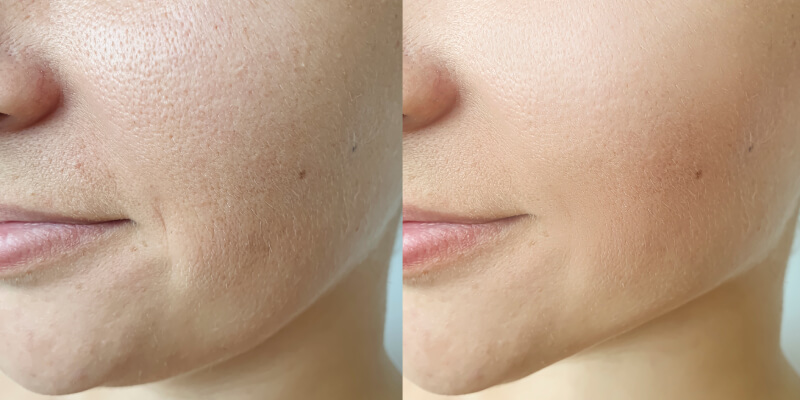
Advantages Of A Thread Lift Over A Facelift
For most people, the biggest advantages of having a thread lift are the significantly reduced recovery time and risks compared to a traditional facelift, and of course, it goes without saying the affordability. As with any medical procedure, a facelift requires the surgeon to give you an anaesthetic; this takes time, uses many products, and has a higher risk, making it a much more expensive procedure.
Recovery from a thread lift is comparatively easy. Thread lifts can be performed under local rather than general anaesthesia, meaning that thread lift patients can drive themselves home and continue with everyday tasks immediately after having their procedure. While some patients will experience a little bit of soreness, bruising and swelling after having a thread lift and wish to take a few days off work, most can return to their normal daily routine instantly. This procedure is, therefore, ideal for people who have children at home or those who have busy, demanding careers.
Thread lifts are low risk, thanks to their non-invasive design. There is virtually no risk of scarring, severe bruising, bleeding or other complications. In very rare cases, patients may experience slight irritation, or their sutures start to become visible under their skin. If this occurs, however, the sutures can simply be removed and repositioned.
Unlike a thread lift, a facelift comes alongside multiple dangerous and potentially life-long problems. These can be unsightly complications that leave you with permanent damage, which is the last thing you want when you’re looking to gain confidence with a tighter face.
Some of the potential side effects of a surgical facelift include:
- Hematoma – this is where blood collates under the skin, causing swelling and uncomfortable pressure. It is a complication that can appear within 24 hours of the surgery taking place and must be treated immediately to prevent damage to the skin.
- Scarring – as a facelift requires incisions, it means that scarring is a likely complication. These scars are usually red and raised in appearance and not only look unappealing but can also make it extremely obvious that surgery has been completed on your face.
- Nerve Injury – while it is rare, nerve injury is another risk of facelifts, both temporary and permanent. This can cause you to lose the ability to open or close your jaw, for example.
- Hair Loss – you can experience permanent or temporary hair loss where the incisions are made.
If you experience any side effects as a result of a surgical facelift, it’s best to consult a GP like Private Doctors MK as soon as possible.
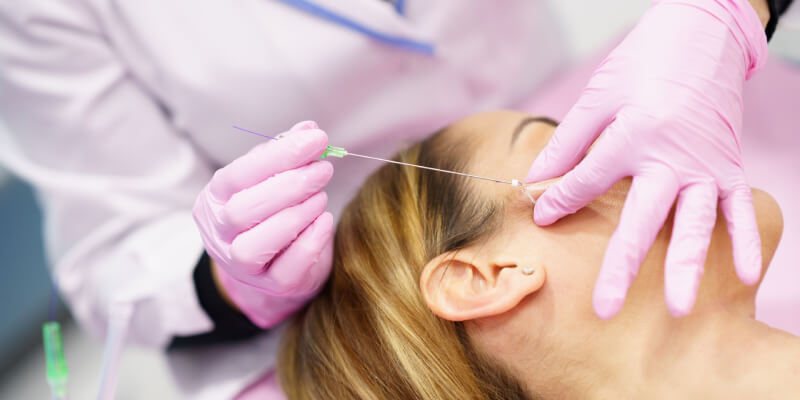
The Ideal Candidate For A Thread Lift
It’s important for patients to maintain realistic expectations, and that’s why a thread lift is best suited to patients dealing with mild to moderate rather than severe signs of skin laxity. While thread lifts undoubtedly produce improved visible changes, they create a more subtle and natural-looking result rather than the drastic results from facelift surgery. In many cases, patients maximise and enhance the overall results of their thread facelift by combining it with a thread neck lift.
The ideal thread lift candidate is usually in their late thirties to early sixties. Thread lifts can, however, provide a facelift alternative for older patients who are unable to have surgery for medical reasons or are afraid to go under the knife.
It’s important to understand that while no lifting technique can produce permanent results, a mini surgical facelift will last 3-5 years and a full surgical facelift around 5-10 years. Typically, for the thread lift, depending on the type of threads used, results can last up to three years. However, because the thread lift procedure has low risk and is far more affordable, patients who like the results of their thread lift usually opt to have a top-up of threads when required.

Celebrities Who Have Had A Thread Lift
The thread lift procedure is becoming increasingly popular thanks, in part, to the countless celebrities and influencers who have been giving it a go and often sharing it on their social media pages. Here are some of the biggest celebrities who have enhanced their appearance with a thread lift:
Eva Mendes
In 2020, retired actress Eva Mendes posted pictures of her thread lift procedure on her Instagram. The 50-year-old was delighted with the procedure, saying the clinic was her ‘happy place’.
Sarah Ferguson
After trying neurotoxins, fillers and mesotherapy, the Dutchess of York was recommended a thread lift by her doctor to stimulate collagen production. In an interview with the Daily Mail, she said, “It’s like garden trellising for sweet peas. You insert the threads under the skin with a fine needle, and they hold everything up. They also encourage collagen production. It takes a couple of months, and then the sweet peas bloom! Before I had it done, I thought, ‘Oh, this is going to be painful,’ but it wasn’t bad. ”
Simon Cowell
Mega business-man and TV personality Simon Cowell is no stranger to cosmetic procedures, and he underwent a thread lift in 2018. The 62-year-old used the procedure to remove sun damage and wrinkles.
Huda Kattan
In 2019, beauty influencer and brand founder Huda Kattan shared that she had a thread lift to the lower face on her blog. She said, “What’s great about thread lifts is they’re super quick, not too painful, and the results last for years.” The 38-year-old added, “You can literally do thread lifting anywhere, and I think my fave way to use it is to tighten the skin at the jaw. Using threads along the jawline is ideal if the skin here starts to sag, as it really lifts and tightens the skin.”
What Are The Threads Made From?
PDO threads are sutures made from a biocompatible material called polydioxanone, which has been specially designed for safe re-absorption by the body. They come in several different varieties: barbed sutures, which are ideal for gathering skin (and therefore producing more lifting action) and straight or smooth sutures. Smooth sutures produce less of a lift, but they are excellent for collagen stimulation. Patients often have smooth sutures placed in strategic locations around their face (such as the corner of the mouth, under the eyes or along the brows) in order to target common problem areas where the signs of ageing become particularly apparent. Barbed sutures, on the other hand, are placed near the hairline to gently pull back the skin and lift the cheeks and jowls.
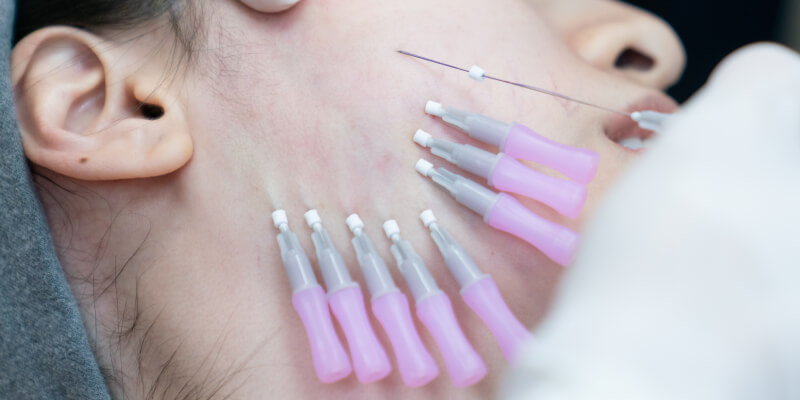
What Happens During The Thread Lift Procedure?
Having a PDO thread facelift is relatively quick and easy for the patient. First, a local anaesthetic will be used to numb the areas that are going to be treated. Then a small instrument (a thin cannula or needle) will be used to insert the threads below the skin, minimising patient discomfort. This entire process usually takes 30 minutes for a facelift and about 45-60 minutes for a face and neck lift combined. The patient is free to return to their normal daily activities afterwards while maintaining the aftercare instructed by the doctor.
Some patients can experience mild soreness and swell for a few days after having the procedure, but this can be managed with painkillers such as paracetamol.
Because thread lifts are so low-risk and boast such a short recovery time, it’s possible to combine them with other non-surgical procedures to create more comprehensive, noticeable results. Once your skin has healed around the threads inserted, you can choose to pair your thread lift with Botox and/or Dermal Fillers to further enhance your treatment. Take a look at our previous article to find out more about Botox and whether it is right for you.
By combining a number of different non-surgical anti-ageing treatments, patients can achieve a profoundly positive change in their appearance without enduring the extended recovery time associated with surgery.
See below for a full PDO thread lift video by LasaDerm.
How Long Does A Thread Lift Last?
PDO threads remain in place for about 3-6 months, after which point they slowly dissolve. Patients can, however, expect to keep seeing the results of their PDO thread lift for up to three years after their treatment. This long-lasting effect arises from the lingering improvement in skin conditions that result from collagen infusion.

Are Thread Lifts Painful?
Before beginning a thread lift, an injectable local anaesthetic is used to numb the treatment area, ensuring the procedure itself is pain-free. This means the only discomfort you will feel during your session is a stinging sensation for a few seconds as the local anaesthetic is injected. You may also feel slight tugging and pulling while the threads are being positioned, but again, this will not be painful.
As mentioned above, you will likely experience swelling and bruising after your thread lift, and the treatment area will inevitably be tender. You will be given full aftercare instructions on how to speed up the healing process.
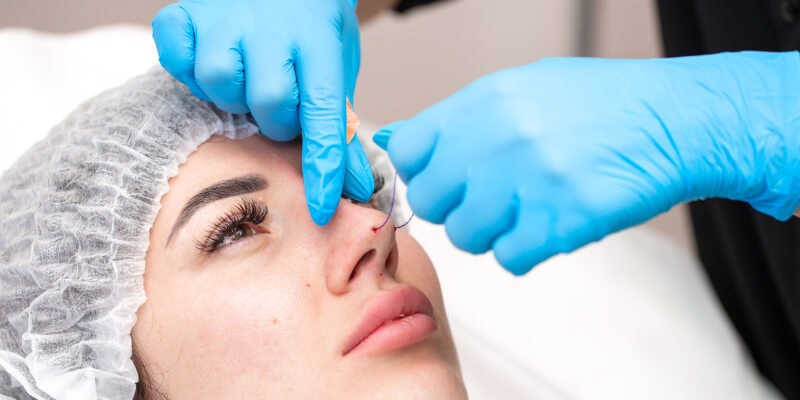
Dos And Don’ts After A Thread Lift
There will always be some form of recovery time after a procedure. Although thread lift recovery is not particularly intensive, patients will still have to take a few minor precautions while healing. For example:
- DON’T undertake excessive exercise for a few days
- DON’T eat tough foods
- DON’T pull at, massage or touch your face for at least 3 weeks after the procedure
- DO take care while yawning
- DO prop yourself up on a few pillows to prevent swelling
- DO try to sleep on your back rather than on your side
- DO try to keep yourself elevated for a couple of weeks after the procedure
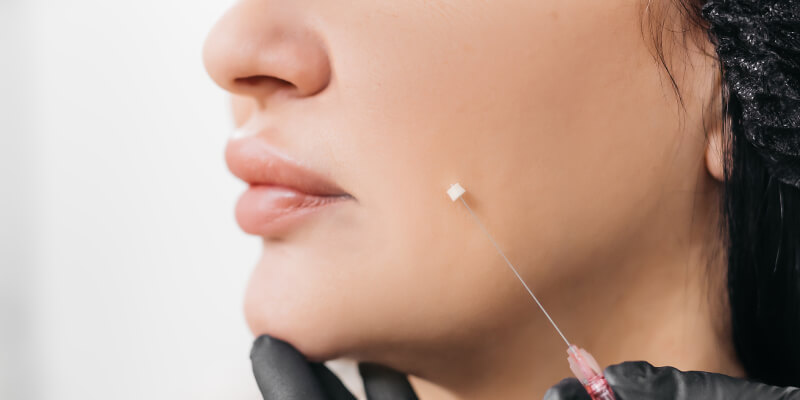
How Much Is A Thread Lift
A thread facelift cost will vary depending on the clinic you choose. While we understand that some clients are working with a budget, we highly recommend that you don’t prioritise the cheapest treatment you can find. In many cases, untrained and inexperienced individuals will charge less than professionals, but this often results in lower-quality materials used and potentially dangerous and long-term side effects. Our prices range from £500 to treat under eye bags to £1,750 for a full face and neck thread lift, including a tweak six weeks after your procedure. For more details about our pricing, check out our prices page or contact us to book a consultation.

Thread Lift Before And After Pictures
Thread lifts provide a more subtle and natural enhancement than many other aesthetic procedures. The skin is left smoother and tighter as the threads dissolve over time, highlighting the face’s natural contours. If you’re still unsure about the procedure, take a look at some of these transformations below for inspiration:
Gain Confidence With LasaDerm
When booking your consultation, be sure to go to a reputable and trained professional. Although there are few risks regarding a thread lift, it is a relatively complex procedure, so it must be carried out by an experienced specialist at an established clinic.
At our cosmetic clinic, all patients start the process with an initial consultation with one of our doctors, who will discuss your requirements and create a tailored treatment plan with ongoing support throughout. If a non-surgical facelift isn’t for you, then you can also benefit from a number of other services, so feel free to contact the team at our cosmetic clinic in Milton Keynes to arrange a consultation.
